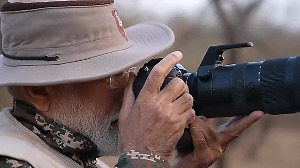Hundreds of rail commuters holding a 'rail satyagraha' between Borivli and Virar stations in Mumbai demanding improvement of services today alleged that Railway police used batons and tear gas on them.
A Western Railway official, however, denied that tear gas and lathi-charge were used against the protesters.
Protesters, demanding improvement in suburban trains services and launching of new shuttle trains, were lathi-charged at Vasai and tear gas was used at Nalla Sopara, some commuters alleged.
Traffic on Borivli-Virar section was disrupted follwing the 'satyagraha' by hundreds of commuters and activists belonging to several non governmental organisations.
The protesters squatted on the tracks at four stations between Borivli and Virar, WR spokesperson Shailendra Kumar told PTI.
The protests were held at Vasai Road, Naigaon, Mira Road and Nallasopra from 0800 hours, he said. Fifteen suburban trains were affected and six long-distance trains were delayed as a result of the protests, he added.
Some passengers complained of being subjected to 'inhuman conditions' due to the overcrowding on trains on the route.
At Vasai Road, former Union Minister and senior Bharatiya Janata Party leader Ram Naik joined the agitation, Kumar said.
"Commuters' associations have demanded that work on expansion of the Borivli-Virar track be completed expeditiously," Kumar added.
The railway protest, organised by a group of 50 organisations, is against inhuman travelling conditions, overcrowding reaching a density of 16-20 person per sq mt during rush hour, and lack of public amenities.
Interestingly, such a pathetic situation exists despite the fact that the WR has almost doubled its capacity in the stretch in the past one and a half decade.
In 1991, there were only 166 services, which now have increased to 248 services. Moreover, the stretch is being served by 12-coach rakes, while in 1991, there were 154 services with 9-coach rakes and only 12 services with 12-coach rakes.
Taking 9-coach trains as the base for calculation, this suggests that the capacity has registered an increase of over 94% from 170 in 1991 to 330 in 2005.
At present, WR runs 1,007 services each day with its 31 12-coach rakes and 33 nine-coach rakes. Beyond Borivli, there are 248 services, accounting for one fourth of the total, catering to Virar (210), Vasai (6) and Bhayander (32). In 1991, services provided to Virar section was making 19% of the total then.
The first phase of the World Bank-funded project for improving train services has stipulated Rs 440 crore for doubling of tracks between Borivli and Virar to be completed by 2007. However, nearly 167 families living in Dahisar slums are hampering the work.
Earlier, the Mumbai Metropolitan Region Development Authority had fixed October 31 as the last day for removing the slums. But nothing has been done so far. Now, MMRDA claims that it will rehabilitate the slums by the year end. The railway has already spent Rs 302 crore on laying extra tracks between Virar and Vasai Road.
Further work on the section is in progress. The suburban services on WR carry 30 lakh passengers per day, of which 7.5 lakh passengers are carried on the Dahisar-Virar section. Annually, the WR from its suburban services gets Rs 425 crore, though it expends nearly Rs 400 crore.
Will the protests and agitations result in more services on the section?
"The issue cannot be solved by adding a few services as it has already reached a saturation point on the Borivli-Virar section. Unless we have more tracks, we cannot increase the services," said Shailendra Kumar, chief public relations officer, WR.
It seems that the city with its burgeoning population cannot just rely on the railways as its backbone. Alternative ways of transportation has to be put in place for a happy commute.
With Business Standard inputs






 © 2025
© 2025